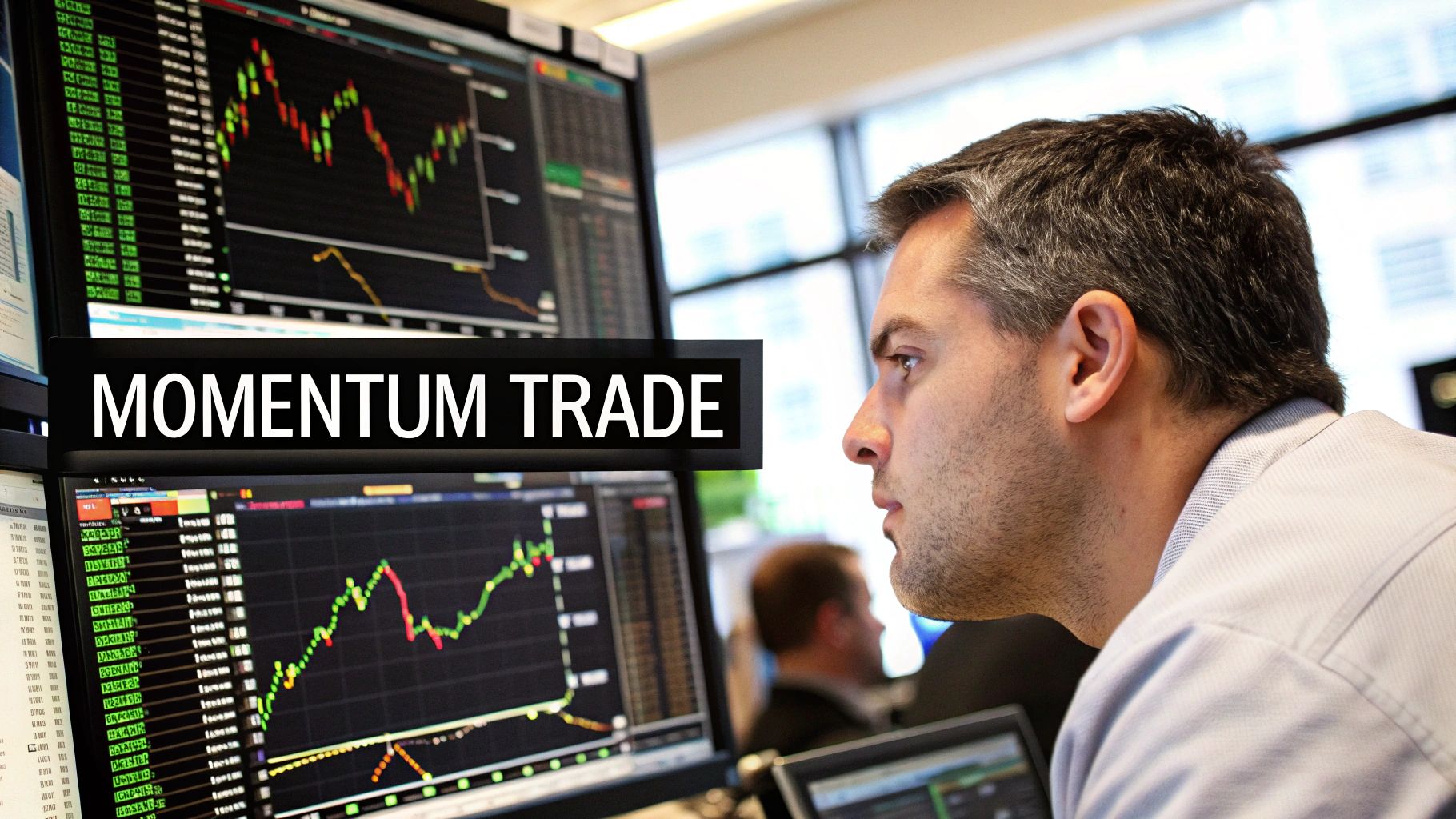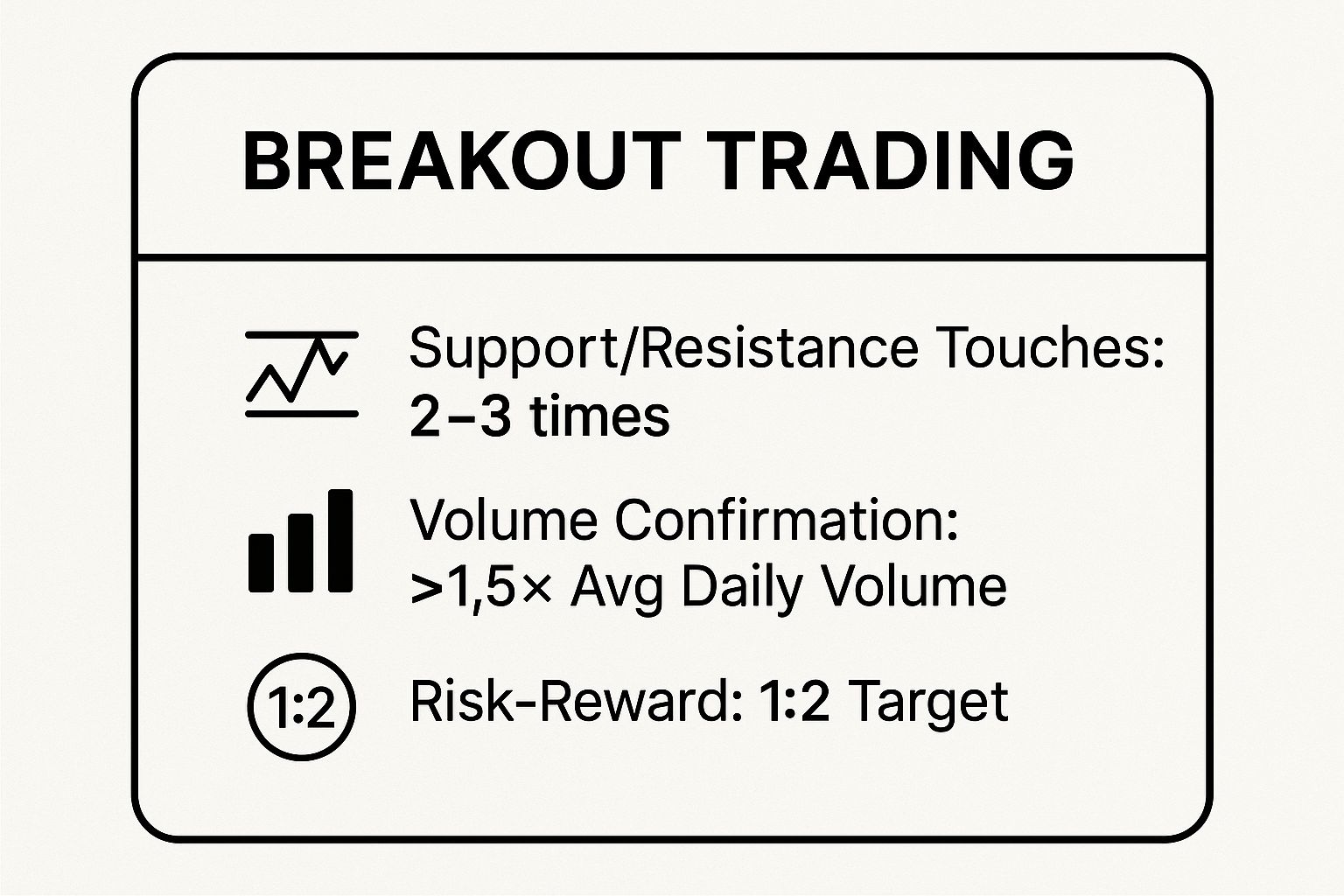Welcome to the world of day trading, where quick decisions and smart strategies can unlock significant opportunities. For a beginner, the market can seem daunting, but with the right approach, it's a field you can learn to navigate with confidence. Since 2014, Trading Made Easy has been dedicated to demystifying the trading industry. Our mission is to empower traders of all levels with innovative tools and education, making sophisticated trading accessible to everyone.
This guide is your first step. We'll break down seven fundamental day trading strategies for beginners, offering clear explanations, actionable tips, and real-world examples. Understanding these core methods is crucial, whether you are a busy professional seeking to trade passively or someone building a new work-from-home career. Our goal is to make complex concepts simple and accessible.
To further support your journey, our automated day trading software is designed to simplify execution and remove emotion from the process, helping you apply these strategies with greater precision. Let’s explore the methods that can help you start your trading journey on the right foot and build a strong day trader mindset.
1. Momentum Trading
Momentum trading is one of the most popular day trading strategies for beginners because it’s based on a simple, powerful concept: an object in motion stays in motion. This strategy involves identifying a stock moving strongly in one direction on high volume and jumping aboard to ride the trend until it shows signs of slowing down. The core idea is to capitalize on the continuation of market trends, not to predict tops or bottoms.

This approach focuses on short-term market sentiment and news catalysts. For example, a pharmaceutical stock might surge after receiving FDA approval, or a tech company like Tesla (TSLA) could see massive volume and price movement following a positive earnings report. Momentum traders aim to capture a piece of these significant, news-driven moves.
How to Implement Momentum Trading
To successfully use this strategy, discipline and quick execution are key. Since 2014, Trading Made Easy has specialized in providing automated day trading software that helps traders execute strategies like this with precision, a crucial advantage when capitalizing on fleeting momentum.
Here are actionable tips to get started:
- Use Pre-Market Scanners: Before the market opens, use scanners to find "stocks in play." Look for stocks with a significant pre-market price gap (up or down) accompanied by high relative volume.
- Confirm with Volume: A price move without strong volume is a warning sign. True momentum is confirmed when high trading volume supports the price trend, indicating strong conviction from the market.
- Set Strict Stop-Losses: Momentum can reverse just as quickly as it begins. Always set a hard stop-loss, typically 2-3% below your entry price, to protect your capital from sharp downturns. Do not chase a stock that has already made a huge move.
Momentum trading is ideal for volatile market conditions where clear trends emerge following specific catalysts. It’s less effective in choppy, sideways markets. For those looking to refine their approach, exploring options like the automated day trading software from Trading Made Easy can provide the high-speed execution needed for this fast-paced strategy.
2. Scalping
Scalping is a high-frequency day trading strategy that aims to profit from very small price changes. Scalpers are like snipers in the market, making dozens or even hundreds of trades in a single day, holding positions for just seconds to a few minutes. The goal isn't to hit a home run on any single trade; instead, it's about accumulating small, consistent profits that add up over the course of the day.

This strategy demands immense focus, discipline, and speed. Scalpers thrive on liquidity and volatility, often trading high-volume stocks like Apple (AAPL) or ETFs like the SPY. The core principle, championed by traders like Harvey Walsh, is to exploit the bid-ask spread and minor price fluctuations that occur constantly throughout the trading day.
How to Implement Scalping
Success in scalping hinges on minimizing costs and maximizing speed, as even small delays or high commissions can erase your profits. Since 2014, Trading Made Easy has provided automated day trading software that gives traders the high-speed execution needed to scalp effectively, helping users sidestep the emotional pressures of making rapid-fire decisions manually.
Here are actionable tips to get started with scalping:
- Choose a Direct-Access Broker: Your broker must offer low commissions and rapid execution. Direct-access brokers provide the speed necessary to get in and out of trades before a small profit vanishes.
- Focus on Highly Liquid Assets: Stick to stocks with daily trading volumes over 1 million shares. High liquidity ensures a tight bid-ask spread, which is crucial for capturing tiny price movements profitably.
- Maintain Iron-Clad Discipline: You must adhere to your pre-defined entry and exit rules without hesitation. A single large loss can wipe out the profits from dozens of successful scalps. Honor your stop-loss on every trade.
Scalping is best suited for traders who can dedicate their full attention to the markets and thrive in a fast-paced environment. It is one of the most demanding day trading strategies for beginners but can be highly rewarding. Using tools like the automated solutions from Trading Made Easy can level the playing field by handling the lightning-fast execution this strategy requires.
3. Breakout Trading
Breakout trading is a classic strategy that involves identifying key price levels, known as support and resistance, and entering a trade when the price moves decisively through them. This approach is built on the idea that once a stock breaks past a significant barrier, it has the momentum to continue moving in that direction. Traders aren't just buying strength; they're buying a confirmed shift in market structure.
This strategy is highly visual and relies on chart patterns. For example, a trader might identify a stock that has tested a resistance level of $50 multiple times without breaking through. A breakout occurs when the price finally pushes past $50, especially with a surge in trading volume. The breakout trader enters a long position, anticipating a further rally. The same logic applies in reverse for breakdowns below support levels, creating shorting opportunities.
How to Implement Breakout Trading
Success with this strategy requires patience to wait for the right setup and the discipline to act quickly when it appears. Identifying valid support and resistance levels is the foundation. Since 2014, Trading Made Easy has developed automated trading solutions that can monitor these levels across multiple markets and execute trades instantly when a breakout is confirmed, removing emotional hesitation from the process.
Here are actionable tips to get started:
- Identify Key Levels: Look for price levels where the stock has reversed multiple times. The more times a level is tested and holds, the more significant the eventual breakout will be. Ideally, look for at least 2-3 touches of a support or resistance line.
- Wait for Volume Confirmation: A breakout on low volume is often a "false breakout" or fakeout. Always look for a significant increase in volume to confirm the market's conviction behind the move. This indicates institutional participation and gives the breakout more credibility.
- Set Your Stop-Loss Immediately: Protect your capital by placing a stop-loss just below the breakout level for a long position, or just above for a short position. This minimizes your loss if the breakout fails and the price reverses.
The following infographic highlights the key data points to look for when confirming a potential breakout opportunity.

These metrics provide a clear framework for qualifying trades, helping you filter out low-probability setups and focus on breakouts with a higher chance of success. Breakout trading is particularly effective in markets that are transitioning from a consolidation phase to a trending phase. For traders interested in applying these principles beyond stocks, breakouts are a core strategy in various markets. You can discover how these concepts apply to futures trading and other asset classes.
4. Range Trading
Range trading, also known as channel trading, is a strategy that thrives when the market isn't trending strongly in one direction. Instead of chasing breakouts, range traders identify stocks moving predictably between two horizontal price levels: a lower level (support) and an upper level (resistance). The core principle is to buy near the support level and sell near the resistance level, profiting from the oscillations within this defined channel.

This method is one of the more intuitive day trading strategies for beginners because it provides clear entry and exit points. It works well on assets that are consolidating or trading sideways, such as the SPY ETF bouncing between key psychological levels or individual stocks taking a breather after a big move. The goal is to repeatedly capture small, consistent gains as the price bounces back and forth like a pinball.
How to Implement Range Trading
Success in range trading requires patience to wait for the price to reach the boundaries of the range and the discipline to act when it does. Since 2014, Trading Made Easy has provided automated day trading software that excels at executing these rule-based strategies, ensuring you buy at support and sell at resistance without emotional interference.
Here are actionable tips to get started:
- Confirm the Range: Don't assume a range exists after just one touch of support and resistance. Look for at least two, preferably three, confirmed touches of each boundary to validate the channel's strength.
- Set Stops Beyond the Range: Your stop-loss orders should be placed just outside the established channel. Set a buy-stop slightly above resistance and a sell-stop slightly below support to protect yourself from a breakout or breakdown.
- Watch for Volume Clues: Pay attention to volume as the price approaches the boundaries. Decreasing volume on the approach can signal the price will respect the level, while a spike in volume could signal an impending breakout.
- Plan Your Exit: Have a clear plan to exit your position if the range breaks. A decisive close outside the channel is a strong signal that the consolidation period is over and a new trend is beginning.
Range trading is most effective in low-volatility, non-trending markets. It's less suitable when major news or economic data is expected, as these events can easily shatter established ranges. For traders seeking a systematic approach, the automated day trading software from Trading Made Easy can help identify and trade these ranges with mechanical precision.
5. Moving Average Crossover
The Moving Average (MA) Crossover is a cornerstone strategy for many technical traders and is one of the most fundamental day trading strategies for beginners. It’s based on a straightforward principle: using the intersection of two moving averages to identify potential shifts in market momentum. When a shorter-term, "faster" moving average crosses above a longer-term, "slower" one, it signals potential upward momentum and generates a buy signal. Conversely, when the faster MA crosses below the slower one, it suggests a downtrend and creates a sell signal.
This strategy helps filter out market "noise" and provides a clear, visual confirmation of trend direction. For example, a day trader might watch for the 9-period exponential moving average (EMA) to cross above the 21-period EMA on a 5-minute chart to enter a long position. The simplicity and clarity of these signals make it an excellent starting point for new traders looking to build a rule-based trading plan.
How to Implement the Moving Average Crossover Strategy
To use this strategy effectively, you must combine its signals with other confirmations to avoid false positives, especially in choppy markets. Since 2014, Trading Made Easy has provided automated trading solutions that can execute crossover-based rules without emotion, a critical advantage when market conditions are indecisive. This automation helps traders stick to their plan with disciplined execution.
Here are actionable tips to get started:
- Choose the Right Moving Averages: Use Exponential Moving Averages (EMAs) over Simple Moving Averages (SMAs). EMAs give more weight to recent prices, making them more responsive to new information, which is crucial for short-term day trading.
- Confirm with Volume: A crossover signal is much more reliable when it occurs on high trading volume. A surge in volume indicates strong conviction behind the move, reducing the chance of a false signal.
- Avoid Sideways Markets: This strategy performs poorly when a stock is consolidating or trading in a tight range. In these conditions, moving averages will frequently cross back and forth, generating multiple false signals. Stick to trading clear, trending markets.
- Set Intelligent Stop-Losses: Place your stop-loss order below a recent swing low (for a long position) or above a recent swing high (for a short position). This is often more effective than basing it on the moving average lines themselves, which can be broken during minor pullbacks.
The crossover strategy provides a disciplined framework for identifying entries and exits. For traders looking to build a solid foundation, mastering this technique is a key step. To see how these principles are applied in a structured system, you can explore the various approaches offered by Trading Made Easy, which simplifies complex strategies for traders at any skill level.
6. Gap Trading
Gap trading is a powerful day trading strategy that focuses on price voids, or "gaps," that occur between a stock's previous closing price and its current opening price. These gaps are often caused by overnight news, earnings announcements, or significant market shifts. Traders aim to profit from the subsequent price action, which can either be a "gap fill" where the price moves back to close the gap, or a "gap and go" where the price continues in the direction of the gap.
This strategy hinges on understanding the catalyst behind the gap. For instance, a pharmaceutical stock might gap up on positive clinical trial news, creating a continuation opportunity. Conversely, a large-cap stock might gap down on an overreaction to an earnings report, presenting a potential gap fill trade as the price normalizes. This is one of the more advanced day trading strategies for beginners, but it can be highly effective.
How to Implement Gap Trading
Successfully trading gaps requires a methodical approach to identify high-probability setups and manage risk effectively. Since 2014, Trading Made Easy has provided automated day trading software that empowers traders to scan for, identify, and execute on these specific opportunities with speed and discipline, removing emotional decision-making from the process.
Here are actionable tips to get started:
- Filter for Significant Gaps: Focus your attention on stocks with a pre-market gap of at least 2%. This ensures the move is significant enough to offer a reasonable profit potential and isn't just market noise.
- Verify with Pre-Market Volume: High pre-market volume is crucial. It confirms institutional interest and provides the liquidity needed to enter and exit trades smoothly. A gap on low volume is often unreliable and risky.
- Set Tight Stop-Losses: Gaps are volatile. Always place a tight stop-loss order, often just above the high of the day for a gap-fill-down trade, or just below the low for a gap-and-go trade. This protects your capital if the trade moves against you.
- Avoid Low-Volume Stocks: Illiquid stocks with wide bid-ask spreads can create unpredictable price action and slippage. Stick to highly liquid stocks when implementing this strategy.
Gap trading is most effective during earnings season or in response to major news events that cause sharp, overnight price changes. For traders looking to systematically find and act on these setups, the automated day trading software from Trading Made Easy can be an indispensable tool for capitalizing on these fleeting market events.
7. Reversal Trading
While momentum trading focuses on riding a trend, reversal trading is about skillfully identifying when that trend is losing steam and about to change direction. This strategy involves pinpointing potential market tops or bottoms, allowing traders to enter a position just as a new trend begins. It's often considered one of the more advanced day trading strategies for beginners, as it requires a keen eye for chart patterns and technical indicators.
Reversal trading is a game of patience and confirmation. Traders using this strategy, popularized by technical analysis legends like John Murphy and Steve Nison, don't just guess when a stock will turn around. Instead, they look for specific clues that the prevailing buying or selling pressure is weakening. For example, a stock in a strong downtrend might form a "hammer" candlestick at a key support level, signaling that buyers are stepping in and a reversal could be imminent.
How to Implement Reversal Trading
Successfully timing a reversal requires more than just one signal; it demands a confluence of evidence. Since 2014, Trading Made Easy has provided automated day trading software that helps traders identify and act on complex patterns with precision, a vital tool when trying to catch a falling knife or sell at the peak.
Here are actionable tips to get started:
- Look for Divergence: A classic reversal signal is divergence between the price and an oscillator like the Relative Strength Index (RSI). If the stock price makes a new high but the RSI makes a lower high, it indicates weakening momentum and a potential reversal down.
- Wait for Confirmation: Don't enter a trade on a single signal. A potential reversal pattern like a double bottom is much more reliable if it's confirmed by a spike in trading volume and a break above a key resistance level.
- Use Tight Stop-Losses: Reversals can fail, and a trend can resume its original course with force. Always place a tight stop-loss just below your entry (for a long trade) or above it (for a short trade) to protect your capital from a failed reversal attempt.
This strategy works best at key historical support and resistance levels where market psychology is most likely to shift. It is less suitable for strongly trending markets with no signs of exhaustion. For traders who want to refine their ability to spot these turning points, the automated trading tools at Trading Made Easy can help automate the process of scanning for and executing on these critical reversal signals.
7 Key Day Trading Strategies Compared
| Strategy | Implementation Complexity 🔄 | Resource Requirements ⚡ | Expected Outcomes 📊 | Ideal Use Cases 💡 | Key Advantages ⭐ |
|---|---|---|---|---|---|
| Momentum Trading | Medium – requires technical indicators and active monitoring | Moderate – access to volume data and scanners | Quick profits in trending markets; high volatility opportunities | Trending markets with strong volume moves | Generates rapid profits; straightforward to identify momentum stocks |
| Scalping | High – very fast trades, requires intense focus | High – direct market access, low latency tech | Small, consistent profits accumulating daily | Highly liquid markets with tight spreads | Limited overnight risk; multiple daily opportunities |
| Breakout Trading | Medium – pattern recognition plus volume confirmation | Moderate – charting tools and volume data | Clear entries, good risk-reward when valid | Breakouts from key support/resistance | Clear entry/exit points; works across timeframes |
| Range Trading | Low to Medium – identifying and timing within ranges | Low – basic charting and oscillators | Profits in sideways markets | Sideways, consolidating markets | Defined risk with boundaries; multiple bounces possible |
| Moving Average Crossover | Low – simple rules, easy to automate | Low – standard moving average data | Reliable trend-following signals in trending markets | Trending markets of any timeframe | Simple, emotion-free; easily automated |
| Gap Trading | Medium – requires gap type identification and pre-market prep | Moderate – pre-market data and volume confirmation | Significant profits from gap fills or continuations | Markets with pronounced overnight moves | Clear setups; good profit potential |
| Reversal Trading | High – requires pattern, momentum, and multi-timeframe analysis | Moderate to High – diverse technical tools | Captures large moves at trend changes | Trend change points, key support/resistance | High reward potential; works both bull and bear markets |
Automate Your Success with Trading Made Easy
Embarking on your journey into the fast-paced world of day trading can feel like learning a new language. You have now been introduced to the core grammar of the market through powerful day trading strategies for beginners, from capitalizing on market momentum to the precision of scalping and the patience of range trading. Each strategy represents a distinct tool for your trading arsenal.
However, understanding the theory behind these strategies is only the first step. The true challenge, and where most new traders falter, lies in the consistent, disciplined, and emotionless execution of these plans. This is the critical gap between knowledge and profitability, and it's precisely this gap that automation is designed to bridge.
Unique Features of Our Automated Trading Software
The difference between a winning trader and a losing one often comes down to split-second decisions and unwavering discipline. Human emotions like fear and greed are notorious for derailing even the most well-researched trading plans. This is where Trading Made Easy transforms your potential into performance.
Our patented, AI-driven platform takes the strategies you've learned about and automates them with precision and speed, offering features that directly benefit you:
- Unmatched Speed: Our software executes trades up to 1,000 times faster than a human can click a mouse. In a market where milliseconds matter, this speed provides a significant competitive edge, especially for strategies like scalping.
- Emotionless Discipline: By automating your chosen strategy, you remove the emotional element. The system executes based on the parameters you set, ensuring you stick to your plan without second-guessing or making impulsive trades.
- Built-in Risk Management: We integrate advanced, automated risk-management protocols directly into the software to help protect your capital, a non-negotiable for anyone serious about long-term trading success.
Success Stories: Real Results Through Automation
Imagine having the discipline of a seasoned professional and the execution speed of a high-frequency trading algorithm working for you. This is the reality for our community of traders.
For instance, one of our users, a retired Green Beret, struggled with the emotional toll of manual trading. After implementing our automated system, he achieved a remarkable 95% success rate, finally finding the consistency that had eluded him. Another trader, a busy professional, was able to participate in the markets without having to watch the charts all day, letting our software execute his strategy while he focused on his career. These stories are not isolated; our traders consistently report how automation has brought them peace of mind and more disciplined results.
We believe that mastering day trading strategies for beginners is the foundation, but automating the execution is how you build a lasting structure for success.
Ready to bridge the gap between knowing a strategy and profiting from it? The key points are clear: understanding core strategies is vital, but disciplined, automated execution is what drives consistent results. Discover how the patented software from Trading Made Easy can implement the very strategies discussed in this article with speed and precision, removing emotion from your trades. We encourage you to explore our offerings by visiting Trading Made Easy to join a free live webinar and see how our U.S.-based team can help you trade with confidence.
Article created using Outrank


Leave a Reply